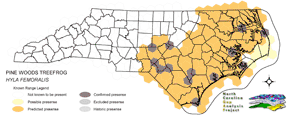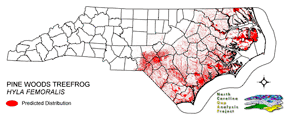
| Taxa: |
| Order: |
| Family: |
| Amphibia |
| Anura |
| Hylidae |
| NatureServe Global Rank: |
| NatureServe State (NC) Rank: |
| G5 |
| S5 |
| Federal Status: |
| NC State Status: |
| --- |
| --- |


| Land Unit |
| US Fish & Wildlife Service |
| US Forest Service |
| US National Park Service |
| US Department of Defense |
| NC State Parks |
| NC University System |
| NC Wildlife Res. Com. |
| NC Forest Service |
| NC Div. of Coastal Mgmt. |
| Local Governments |
| Non-Governmental Org. |
| Other Public Lands |
| Private Lands |
| GAP Status 1-2 |
| All Protected Lands |
| Statewide |
| Hectares |
| 105,093.09 |
| 49,099.32 |
| 96,613.29 |
| 342.54 |
| 13,632.03 |
| 21,371.58 |
| 73,378.08 |
| 7,966.62 |
| 7,005.06 |
| 340.29 |
| 17,835.21 |
| 454.14 |
| 1,248,303.69 |
| 204,456.60 |
| 392,281.74 |
| 1,641,434.94 |
| Acres |
| 259,690.63 |
| 121,327.04 |
| 238,736.59 |
| 846.43 |
| 33,685.47 |
| 52,810.31 |
| 181,321.15 |
| 19,685.94 |
| 17,309.88 |
| 840.87 |
| 44,071.76 |
| 1,122.20 |
| 3,084,624.99 |
| 505,223.16 |
| 969,349.10 |
| 4,056,073.28 |
| % of Dist. on |
| Prot. Lands |
| 26.8 % |
| 12.5 % |
| 24.6 % |
| < 0.1 % |
| 3.5 % |
| 5.4 % |
| 18.5 % |
| 2.0 % |
| 1.8 % |
| 4.5 % |
| 4.5 % |
| < 0.1 % |
| < 0.1 % |
| 52.1 % |
| ----- |
| ----- |
| % of Dist. on |
| All Lands |
| 6.4 % |
| 3.0 % |
| 5.9 % |
| < 0.1 % |
| 0.8 % |
| 1.3 % |
| 4.5 % |
| 0.5 % |
| 0.4 % |
| < 0.1 % |
| 1.1 % |
| < 0.1 % |
| 76.0 % |
| 12.5 % |
| ----- |
| ----- |
|
Mostly arboreal, this species can be found from low shrubs to high tree tops and occasionally on the ground (Conant and Collins 1998). It lives in pine flatwoods and savannas, usually near bogs, ponds, and other wetlands (Conant and Collins 1998, Martof et al. 1980, Wilson 1995). It is occasionally found in hardwood forests and swamps (Martof et al.
1980). It breeds in transient pools, ditches, cypress ponds and bays (Wright and Wright 1949). NATURE SERVE GLOBAL HABITAT COMMENTS: Pine flatwoods and savannas and pine-turkey oak, usually near bogs or ponds. Occasionally found in hardwood forests and swamps. Mostly arboreal, from low shrubs to high tree tops. Hides under or in rotting logs, stumps, or snags during dry or cold weather. Eggs and larvae develop in flooded ditches and transient pools and ponds, occasionally in cypress swamps. |
| Code | Name | Description | NC Natural Heritage Program Equivalent |
| 121 | Maritime Pinelands | Loblolly forests and woodlands of the outer coastal plain. | Estuarine Fringe Loblolly Pine Forest |
| 126 | Interdune Wooded Depression Swamp | Includes swamps dominated by sweetbay and swampbay or dogwood dominated forests. | Maritime Shrub Swamp, Maritime Swamp Forest |
| 380 | Coastal Plain Fresh Water Emergent | Emergent vegetation in fresh water seepage bogs, ponds and riverbeds of the coastal plain. Includes alliances dominated by sedges, eelgrass, as well as cane found in unforested cane-brakes. | Small Depression Pond, Sandhill Seep, Floodplain Pool, Unforested Floodplain Canebrake, Riverscour Prairies, Vernal Pools |
| 173 | Coastal Plain Riverbank Shrubs | Shrub dominated riverbanks, commonly dominated by willows and/or alders. | Sand and Mud Bar |
| 49 | Coastal Plain Oak Bottomland Forest | Bottomland forests dominated by deciduous oak alliances. Oaks represented can include swamp chestnut, cherrybark, willow, and/or overcup oak. Inclusions of loblolly pine temporarily flooded forests occur in patches. Hydrology is temporarily to seasonally flooded. | Coastal Plain Bottomland Hardwoods (in part) blackwater subtype, brownwater subtype |
| 158 | Coastal Plain Nonriverine Wet Flat Forests | Loblolly pine - Atlantic white-cedar - red maple - swamp tupelo saturated forests as well as forests dominated by loblolly, sweetgum, and red maple in non-riverine flats. | Non-riverine Wet Hardwood Forest |
| 41 | Peatland Atlantic White-Cedar Forest | Dense stands of Atlantic white cedar with saturated hydrology. Can include swamp tupelo, red maple, and pond pines with a moderate shrub and herb layer. | Peatland Atlantic White-Cedar Forest |
| 15 | Seepage and Streamhead Swamps | Includes extensive peat flats in the coastal plain, dominated by swamp tupelo, maples, and Atlantic white cedar alliances. In the sandhills includes streamhead pond pine and bay forests alliances. Saturated hydrology. | Bay Forest, Small Depression Pocosin, Streamhead Atlantic White Cedar Forest, Streamhead Pocosins |
| 30 | Cypress-Gum Floodplain Forests | Swamps dominated by black or swamp tupelo with or without Taxodium. Seasonally to semi-permanently flooded hydrology. | Cypress-Gum Swamps |
| 78 | Pond-Cypress - Gum Swamps, Savannas and Lakeshores | Cypress dominated swamps and lakeshores. Can include bays dominated by pond cypress or shorelines of coastal plain lakes with a narrow band of cypress. | Non-riverine Swamp Forest, Natural Lakeshores (in part) |
| 385 | Oak Bottomland Forest and Swamp Forest | The swamp chestnut oak, cherrybark oak, shumard oak and sweetgum alliance is one representative. Other alliances are dominated by water, willow, and overcup oaks. Swamp forests can be dominated by sweetgum, red maple, and black gum being dominant. Loblolly can occur in combination with sweetgum and red maple, or with tulip poplar. Includes saturated and semi- to permanently flooded forests in the mountains. | Piedmont/Mountain Bottomland Forest, Piedmont/Mountain Swamp Forest |
| 87 | Pocosin Woodlands and Shrublands | Includes pond pine woodland, low pocosin and high pocosin shrub dominated areas. Canebrakes and bay forests may be present. | Pond Pine Woodlands, Peatland Canebrake, Small Depression Pocosin |
| 67 | Wet Longleaf or Slash Pine Savanna | Wet flatwoods and pine savannas, typically dominated by longleaf pines, but slash or pond pines may be the dominant pines. | Wet Pine Flatwoods |
| 97 | Mesic Longleaf Pine | Longleaf pine woodlands without a major scrub oak component. Slash or loblolly pines may be present as well. | Mesic Pine Flatwoods |
| 42 | Xeric Longleaf Pine | Sandhills including a range of longleaf pine density from predominantly wiregrass, scrub oak dominated to true longleaf pine woodland. This does not include mesic or saturated flatwood types. | Xeric Sandhill Scrub, Pine/Scrub Oak Sandhill, Coastal Fringe Sandhill |
| 46 | Xeric Oak - Pine Forests | Mixed forest dominated by yellow pines with white or northern red oaks co-dominating. | Pine Oak Heath |
| 239 | Piedmont/Mountain Emergent Vegetation | Emergent vegetation of all wetland hydrologies. Sites would commonly support species such as tussock sedge, rushs, and cattail alliances. | Rocky Bar and Shore (in part) |
| 267 | Riverbank Shrublands | Riverside shrubs with temporarily flooded hydrologies. Found in the both the Mountains and Piedmont. Containing dominants such as smooth alder and a Carolina or black willows. | Sand and Mud Bar |
| 269 | Floodplain Wet Shrublands | Saturated shrublands of the Piedmont, includes buttonbush, swamp-loosestrife, decodon and alders. | Piedmont/mountain Semipermanent Impoundment |
| 8 | Open water | Open water without aquatic vegetation. | No equivalent |
|
Hoffman, R. L. 1988. HYLA FEMORALIS. Cat. Am. Amph. Rep. 436:1-3.
Wright, A. H. and A. A. Wright. 1949. Handbook of frogs and toads of the United States and Canada. Comstock Publishing Company, Ithica, NY. 640 pp. Wilson, L. A. 1995. The Land Manager's Guide to the amphibians and reptiles of the South. Chapel Hill, NC: The Nature Conservancy. Conant, R. 1975. A Field Guide to Reptiles and Amphibians of Eastern and Central North America. Second Edition. Houghton Mifflin Company, Boston, Massachusetts. xvii + 429 pp. Mount, R. H. 1975. The Reptiles and Amphibians of Alabama. Auburn University Agricultural Experiment Station, Auburn, Alabama. vii + 347 pp. Behler, J. L., and F. W. King. 1979. The Audubon Society field guide to North American reptiles and amphibians. Alfred A. Knopf, New York. 719 pp. Martof, B. S., W. M. Palmer, J. R. Bailey, and J. R. Harrison, III. 1980. Amphibians and reptiles of the Carolinas and Virginia. University of North Carolina Press, Chapel Hill, North Carolina. 264 pp. |
For more information please contact them at:
NC-GAP Analysis Project
Dept. of Zoology, NCSU
Campus Box 7617
Raleigh, NC 27695-7617
(919) 513-2853
www.basic.ncsu.edu/ncgap